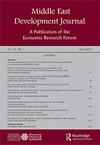Beware of the echo: the evolution of Egypt’s population and labor force from 2000 to 2050
IF 0.8
Q4 DEVELOPMENT STUDIES
引用次数: 2
Abstract
ABSTRACT I argue in this paper that although recent developments had temporarily reduced demographic pressures on the Egyptian labor market, such pressures will return with a vengeance in the next decade. The sizable echo generation born between 2005 and 2015 is the reflection of the large youth bulge generation born in the early 1980s; a reflection that was further compounded by rising fertility rates in the late 2000s and early 2010s. As the echo generation reaches working age, the net annual increase to the labor force will rise from 575 thousand per year in 2020–25 to 800 thousand per year in 2030–35, which will pose a major job creation challenge. This upcoming wave of new entrants will also be substantially more educated, with 50–60 percent having secondary or post-secondary education, and another third having university education or higher. To accommodate this upcoming growth in labor supply and absorb the stock of existing unemployed and discouraged workers, I estimate that employment growth would have to reach 2.7 percent per year, something that would require sustained GDP growth rates in excess of 6 percent per year. The quality of jobs created by the Egyptian economy would also have to improve substantially to satisfy the higher aspirations of the increasingly educated new entrants and curtail the rising rates of discouragement among female new entrants.警惕回声:2000年至2050年埃及人口和劳动力的演变
摘要我在本文中认为,尽管最近的发展暂时减轻了埃及劳动力市场的人口压力,但这种压力将在未来十年卷土重来。2005年至2015年出生的相当大的回声一代反映了20世纪80年代初出生的大量年轻人;2000年代末和2010年代初生育率的上升进一步加剧了这一反映。随着回声一代达到工作年龄,劳动力的年净增长将从2020-2025年的57.5万人上升到2030-35年的80万人,这将对创造就业构成重大挑战。即将到来的这一波新入学者也将受到更多的教育,其中50-60%的人受过中等或高等教育,另有三分之一的人受过大学或更高学历。为了适应即将到来的劳动力供应增长,并吸收现有失业和气馁工人的存量,我估计就业增长必须达到每年2.7%,这需要每年超过6%的持续GDP增长率。埃及经济创造的就业质量也必须大幅提高,以满足受教育程度越来越高的新入学者的更高愿望,并遏制女性新入学者日益增长的沮丧情绪。
本文章由计算机程序翻译,如有差异,请以英文原文为准。
求助全文
约1分钟内获得全文
求助全文

 求助内容:
求助内容: 应助结果提醒方式:
应助结果提醒方式:


